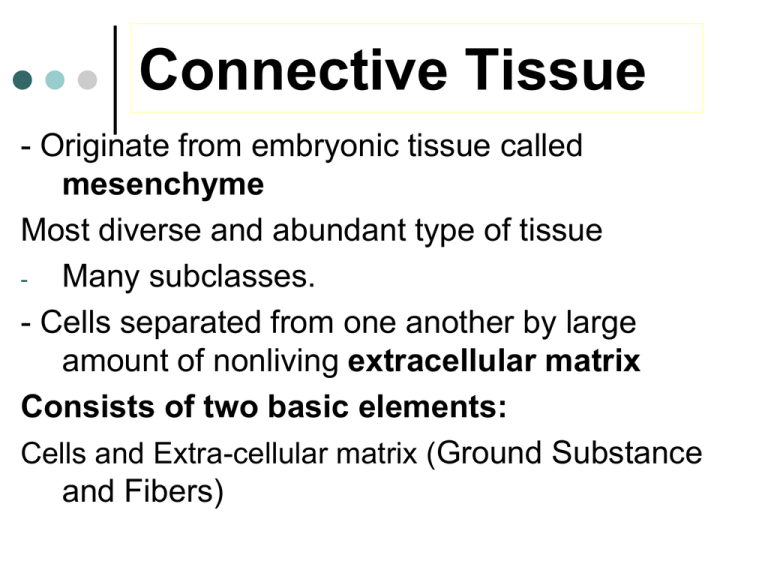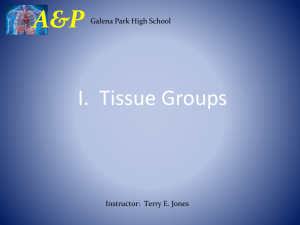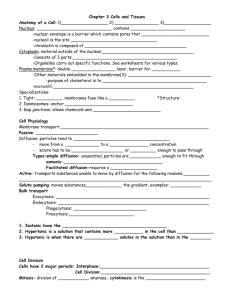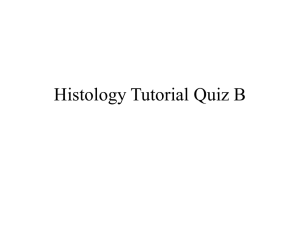Supportive Connective Tissue
advertisement

Connective Tissue - Originate from embryonic tissue called mesenchyme Most diverse and abundant type of tissue Many subclasses. - Cells separated from one another by large amount of nonliving extracellular matrix Consists of two basic elements: Cells and Extra-cellular matrix (Ground Substance and Fibers) True Connective Tissue Cells Fibroblasts: Secrete both fibers and ground substance of the matrix (wandering) Macrophages: Phagocytes that develop from Monocytes (wandering or fixed) Plasma Cells: Antibody secreting cells that develop from B Lymphocytes Mast Cells: Produce histamine that help dilate small blood vessels in reaction to injury Adipocytes: Fat cells that store triglycerides, support, protect and insulate (fixed) Extracellular Matrix explained Nonliving material between cells Produced by the cells and then extruded Responsible for the strength Two components 1. Ground substance Of fluid, adhesion proteins, proteoglycans Liquid, semisolid, gel-like or very hard 2. Fibers: collagen, elastic or reticular Matrix Fibers Collagen Fibers: Large fibers made of the protein collagen and are typically the most abundant fibers. Promote tissue flexibility. Elastic Fibers: Intermediate fibers made of the protein elastin. Branching fibers that allow for stretch and recoil Reticular Fibers: Small delicate, branched fibers that have same chemical composition of collagen. Forms structural framework for organs such as spleen and lymph nodes. Fiber Types Elastic Fiber Reticular Fibers Collagen Fiber Matrix Ground Substance Hyaluronic Acid: Complex combination of polysaccharides and proteins found in “true” or proper connective tissue. Chondroitin sulfate: Jellylike ground substance of cartilage, bone, skin and blood vessels. Other ground Substances: Dermatin sulfate, keratin sulfate, and adhesion proteins Basic functions of connective tissue reviewed Support and binding of other tissues Holding body fluids Defending the body against infection macrophages, plasma cells, mast cells, WBCs Storing nutrients as fat TYPES OF CONNECTIVE TISSUE 1. True Connective Tissue a. Loose Connective Tissue b. Dense Connective Tissue 2. Supportive Connective Tissue a. Cartilage b. Bone 3. Liquid Connective Tissue a. Blood True or Proper Connective Tissue 1. Loose Connective Tissue: a. Areolar tissue Widely distributed under epithelia b. Adipose tissue Hypodermis, within abdomen, breasts c. Reticular connective tissue Lymphoid organs such as lymph nodes LOOSE Connective Tissue: 1. Areolar CT consists of all 3 types of fibers, several types of cells, and semi-fluid ground substance found in subcutaneous layer and mucous membranes, and around blood vessels, nerves and organs function = strength, support and elasticity Fibroblast Collagen Fiber Elastic Fiber LOOSE Connective Tissue: 2. Adipose tissue consists of adipocytes; "signet ring" appearing fat cells. They store energy in the form of triglycerides (lipids). found in subcutaneous layer, around organs and in the yellow marrow of long bones function = supports, protects and insulates, and serves as an energy reserve LOOSE Connective Tissue: 3. Reticular CT Consists of fine interlacing reticular fibers and reticular cells Found in liver, spleen and lymph nodes Function = forms the framework (stroma) of organs and binds together smooth muscle tissue cells Reticular Fibers Macrophage True or Proper Connective Tissue 2. Dense Connective Tissue: a. Dense regular connective tissue Tendons and ligaments b. Dense irregular connective tissue Dermis of skin, submucosa of digestive tract Dense Connective Tissue: contains more numerous and thicker fibers and far fewer cells than loose CT 1. dense regular Connective Tissue consists of bundles of collagen fibers and fibroblasts forms tendons, ligaments and aponeuroses Function = provide strong attachment between various structures Collagen Fiber Fibroblast Dense Connective Tissue: 2. Dense Irregular CT consists of randomly-arranged collagen fibers and a few fibroblasts Found in fasciae, dermis of skin, joint capsules, and heart valves Function = provide strength Supportive Connective Tissue: CARTILAGE: Jelly-like matrix (chondroitin sulfate) containing collagen and elastic fibers and chondrocytes surrounded by a membrane called the perichondrium. Unlike other CT, cartilage has NO blood vessels or nerves except in the perichondrium. The strength of cartilage is due to collagen fibers and the resilience is due to the presence of chondroitin sulfate. Chondrocytes occur within spaces in the matrix called lacunae. Supportive Connective Tissue 1. 2. 3. Hyaline cartilage Fibrocartilage Elastic cartilage Supportive Connective Tissue: 1. Hyaline Cartilage (most abundant type) fine collagen fibers embedded in a gel-type matrix. Occasional chondrocytes inside lacunae. Found in embryonic skeleton, at the ends of long bones, in the nose and in respiratory structures. Function= flexible, provides support, allows movement at joints Extracellular matrix Lacunae Chondrocyte Supportive Connective Tissue: 2. Fibrocartilage contains bundles of collagen in the matrix that are usually more visible under microscopy. Found in the pubic symphysis, intervertebral discs, and menisci of the knee. Function = support and fusion, and absorbs shocks. Chondrocyte Collagen Fiber Supportive Connective Tissue: 3. Elastic Cartilage threadlike network of elastic fibers within the matrix. found in external ear, auditory tubes, epiglottis. function = gives support, maintains shape, allows flexibility Lacunae Chondrocyte BODY MEMBRANES Epithelial Membranes = epithelial layer of cells plus the underlying connective tissue. Cutaneous membranes Skin: epidermis and dermis Mucous membranes, or mucosa Lines every hollow internal organ that opens to the outside of the body Serous membranes, or serosa Slippery membranes lining the pleural, pericardial and peritoneal cavities The fluid formed on the surfaces is called a transudate Synovial membranes Line joints Membranes that combine epithelial sheets plus underlying connective tissue proper Cutaneous membranes Mucous membranes, or mucosa Lines every hollow internal organ that opens to the outside of the body Serous membranes, or serosa Skin: epidermis and dermis Slippery membranes lining the pleural, pericardial and peritoneal cavities The fluid formed on the surfaces is called a transudate Synovial membranes Line joints BODY MEMBRANES 1. Mucous membrane = mucosa; it lines cavities that open to the exterior, such as the GI tract. The epithelial layer of the mucous membrane acts as a barrier to disease organisms. The connective tissue layer of the mucous membrane is called the lamina propria. Found as the lining of the mouth, vagina, and nasal passage. BODY MEMBRANES 2. Serous membrane = serosa, membrane lines a body cavity that does NOT open to the exterior and it covers the organs that lie within the cavity. a. pleura = lungs b. pericardium = heart c. peritoneum = abdomen The serous membrane has two portions: 1. parietal portion = lining outside the cavity. 2. visceral portion = covers the organ. . BODY MEMBRANES Serous membranes epithelial layer secretes a lubricating SEROUS FLUID, that reduces friction between organs and the walls of the cavities in which they are located. The serous fluid is named by location: Pleural fluid is found between the parietal and visceral pleura of the lungs. Pericardial fluid is found between the parietal and visceral pericardium of the heart. Peritoneal fluid is found between the parietal and visceral peritoneum of the abdomen. (a) Cutaneous membrane (b) Mucous membrane (c) Serous membrane BODY MEMBRANES BODY MEMBRANES BODY MEMBRANES






